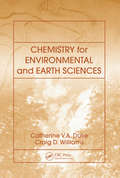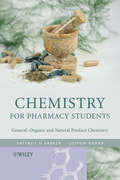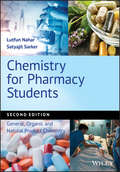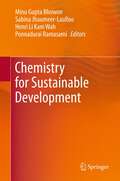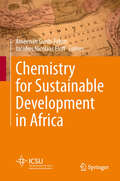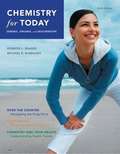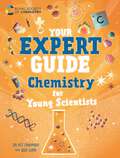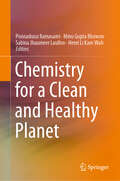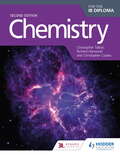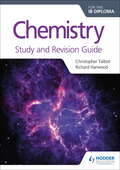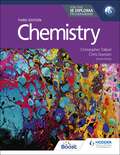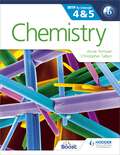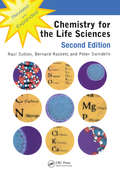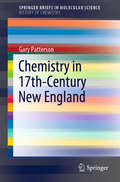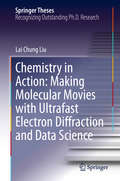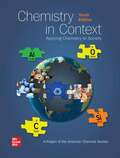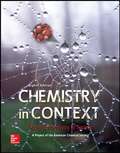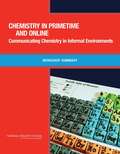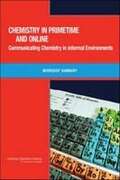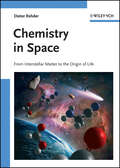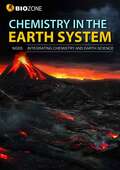- Table View
- List View
Chemistry for Environmental and Earth Sciences
by Catherine Vanessa Duke Craig Denver WilliamsChemistry for Environmental and Earth Sciences focuses on the chemistry and processes behind environmental issues such as global warming, ozone depletion, acid rain, water pollution, and soil contamination. Accessible to science as well as non-science majors, this textbook is divided into four intuitive chapters: Fire, Earth, Water, and Air. It uses worked examples and case studies drawn from current applications along with clear diagrams and concise explanations to illustrate the relevance of chemistry to geosciences. In-text and end-of-chapter questions with complete solutions also help students gain confidence in applying concepts from this book towards solving current, real-world problems.
Chemistry for Pharmacy Students
by Lutfun Nahar Satyajit Sarker"This book has succeeded in covering the basic chemistry essentials required by the pharmaceutical science student... the undergraduate reader, be they chemist, biologist or pharmacist will find this an interesting and valuable read." -Journal of Chemical Biology, May 2009Chemistry for Pharmacy Students is a student-friendly introduction to the key areas of chemistry required by all pharmacy and pharmaceutical science students. The book provides a comprehensive overview of the various areas of general, organic and natural products chemistry (in relation to drug molecules).Clearly structured to enhance student understanding, the book is divided into six clear sections. The book opens with an overview of general aspects of chemistry and their importance to modern life, with particular emphasis on medicinal applications. The text then moves on to a discussion of the concepts of atomic structure and bonding and the fundamentals of stereochemistry and their significance to pharmacy- in relation to drug action and toxicity. Various aspects of aliphatic, aromatic and heterocyclic chemistry and their pharmaceutical importance are then covered with final chapters looking at organic reactions and their applications to drug discovery and development and natural products chemistry.accessible introduction to the key areas of chemistry required for all pharmacy degree coursesstudent-friendly and written at a level suitable for non-chemistry studentsincludes learning objectives at the beginning of each chapterfocuses on the physical properties and actions of drug molecules
Chemistry for Pharmacy Students: General, Organic and Natural Product Chemistry
by Lutfun Nahar Satyajit SarkerIntroduces the key areas of chemistry required for all pharmacy degree courses and focuses on the properties and actions of drug molecules This new edition provides a clear and comprehensive overview of the various areas of general, organic, and natural products chemistry (in relation to drug molecules). Structured to enhance student understanding, it places great emphasis on the applications of key theoretical aspects of chemistry required by all pharmacy and pharmaceutical science students. This second edition particularly caters for the chemistry requirements in any ‘Integrated Pharmacy Curricula’, where science in general is meant to be taught ‘not in isolation’, but together with, and as a part of, other practice and clinical elements of the course. Chemistry for Pharmacy Students: General, Organic and Natural Product Chemistry, 2nd Edition is divided into eight chapters. It opens with an overview of the general aspects of chemistry and their importance to modern life, with emphasis on medicinal applications. The text then moves on to discuss the concepts of atomic structure and bonding and the fundamentals of stereochemistry and their significance to pharmacy in relation to drug action and toxicity. Various aspects of organic functional groups, organic reactions, heterocyclic chemistry, nucleic acids and their pharmaceutical importance are then covered in subsequent chapters, with the final chapter dealing with drug discovery and development, and natural product chemistry. Provides a student-friendly introduction to the main areas of chemistry required by pharmacy degree courses Written at a level suitable for non-chemistry students in pharmacy, but also relevant to those in life sciences, food science, and the health sciences Includes learning objectives at the beginning of each chapter Focuses on the physical properties and actions of drug molecules Chemistry for Pharmacy Students: General, Organic and Natural Product Chemistry, 2nd Edition is an essential book for pharmacy undergraduate students, and a helpful resource for those studying other subject areas within pharmaceutical sciences, biomedical sciences, cosmetic science, food sciences, and health and life sciences.
Chemistry for Sustainable Development
by Henri Li Kam Wah Ponnadurai Ramasami Minu Gupta Bhowon Sabina Jhaumeer-LaullooChemistry for Sustainable Development is a collection of selected papers by the participants of the International Conference on Pure and Applied Chemistry (ICPAC 2010) on the theme of "Chemistry for Sustainable Development" held in Mauritius in July 2010. In light of the significant progresses and challenges in the development and implementation of green and sustainable chemistry, this volume reviews the recent results generated by a more efficient use of resources to minimize carbon footprints, to foster the eradication or minimisation of solvent use in chemistry, and to deliver processes which lead to increased harmony between chemistry and the environment. Chemistry for Sustainable Development is written for graduates, postgraduates, researchers in industry and academia who have an interest in the fields ranging from fundamental to applied chemistry.
Chemistry for Sustainable Development in Africa
by Ameenah Gurib-Fakim Jacobus Nicolaas EloffChemistry for Sustainable Development in Africa gives an insight into current Chemical research in Africa. It is edited and written by distinguished African scientists and includes contributions from Chemists from Northern, Southern, Western, Eastern, Central and Island state African Countries. The core themes embrace the most pressing issues of our time, including Environmental Chemistry, Renewable Energies, Health and Human Well-Being, Food and Nutrition, and Bioprospecting and Commercial Development. This book is invaluable for teaching and research institutes in Africa and worldwide, private sector entities dealing with natural products from Africa, as well as policy and decision-making bodies and non-governmental organizations.
Chemistry for Today: General, Organic, and Biochemistry
by Spencer L. Seager Michael R. SlabaughYou will quickly gain a comprehensive understanding of chemistry with this new Sixth Edition of CHEMISTRY FOR TODAY: GENERAL, ORGANIC, AND BIOCHEMISTRY. Using real-life applications and interactive technology tools, this text will show you how chemistry relates to health science. The thorough integration of online assessment and learning tools turns study time into experiences with chemistry--helping you gain true comprehension of chemical concepts. CHEMISTRY FOR TODAY will help dispel any fear you may have of chemistry as it helps you appreciate the role chemistry plays in our daily lives through a rich pedagogical structure and an accessible writing style with lucid explanations. In addition, Seager and Slabaugh's CHEMISTRY FOR TODAY provides greater support in both the problem-solving and critical-thinking skills needed to succeed in chemistry. By illustrating how this information will help your future career and providing important career information online, the authors help you set goals and focus on achieving them.
Chemistry for Young Scientists (Your Expert Guide #2)
by Dr Dr Kit ChapmanFrom a top expert in the world of science comes this definitive and clear guide to chemistry, published in partnership with the Royal Society of Chemistry.In Your Expert Guide: Chemistry for Young Scientists, discover the foundations of this crucial and exciting branch of science. Learn to think like a chemist, stay safe in the lab and explore the chemical building blocks of everything around you - from the air we breathe and the water we drink, to rockets, smartphones, stars and our bodies. Get an expert view of how chemistry underpins our understanding of matter on Earth and beyond!Written by Dr Kit Chapman, award-winning science journalist, academic at Falmouth University and global science communicator. Published in partnership with The Royal Society of Chemistry, the internationally renowned nonprofit organisation with the same mission since 1841: to advance excellence in the chemical sciences. With approachable artwork by Dao Linh, see the elements come alive for curious readers aged 8+.Books in the Your Expert Guide series:With Royal Society of Chemistry: The Periodic Table / Chemistry for Young ScientistsWith Royal Society of Biology: The Human Body / Biology for Young ScientistsWith Institute of Physics: The Universe / Physics for Young Scientists
Chemistry for a Clean and Healthy Planet
by Henri Li Kam Wah Ponnadurai Ramasami Minu Gupta Bhowon Sabina Jhaumeer LaullooThese proceedings gather carefully selected, peer-reviewed contributions from the International Conference on Pure and Applied Chemistry (ICPAC 2018). The event, the latest installment in a biennial conference series, was held in July 2018 in Mauritius.The respective chapters in this unique collection reflect a wide range of fundamental and applied research in the chemical sciences and various interdisciplinary subjects. In addition to reviews, they highlight cutting-edge advances.
Chemistry for the IB Diploma Second Edition
by Christopher Coates Christopher Talbot Richard HarwoodProvide clear guidance to the 2014 changes and ensure in-depth study with accessible content, directly mapped to the new syllabus and approach to learningThis second edition of the highly-regarded first edition contains all SL and HL content, which is clearly identified throughout. Options are available free online, along with appendices and data and statistics.- Improve exam performance, with exam-style questions, including from past papers- Integrate Theory of Knowledge into your lessons and provide opportunities for cross-curriculum study- Stretch more able students with extension activities- The shift to concept-based approach to learning , Nature of Science, is covered by providing a framework for the course with points for discussion - Key skills and experiments included - Full digital package - offered in a variety of formats so that you can deliver the course just how you like!
Chemistry for the IB Diploma Second Edition
by Christopher Coates Christopher Talbot Richard HarwoodProvide clear guidance to the 2014 changes and ensure in-depth study with accessible content, directly mapped to the new syllabus and approach to learningThis second edition of the highly-regarded first edition contains all SL and HL content, which is clearly identified throughout. Options are available free online, along with appendices and data and statistics.- Improve exam performance, with exam-style questions, including from past papers- Integrate Theory of Knowledge into your lessons and provide opportunities for cross-curriculum study- Stretch more able students with extension activities- The shift to concept-based approach to learning , Nature of Science, is covered by providing a framework for the course with points for discussion - Key skills and experiments included - Full digital package - offered in a variety of formats so that you can deliver the course just how you like!
Chemistry for the IB Diploma Study and Revision Guide
by Christopher Talbot Richard HarwoodStretch your students to achieve their best grade with these year round course companions; providing clear and concise explanations of all syllabus requirements and topics, and practice questions to support and strengthen learning. - Consolidate revision and support learning with a range of exam practice questions and concise and accessible revision notes- Practise exam technique with tips and trusted guidance from examiners on how to tackle questions- Focus revision with key terms and definitions listed for each topic/sub topic
Chemistry for the IB Diploma Study and Revision Guide
by Christopher Talbot Richard HarwoodExam Board: IBLevel: IBSubject: ChemistryFirst Teaching: September 2014First Exam: Summer 2016Stretch your students to achieve their best grade with these year round course companions; providing clear and concise explanations of all syllabus requirements and topics, and practice questions to support and strengthen learning. - Consolidate revision and support learning with a range of exam practice questions and concise and accessible revision notes- Practise exam technique with tips and trusted guidance from examiners on how to tackle questions- Focus revision with key terms and definitions listed for each topic/sub topic
Chemistry for the IB Diploma Third edition (For the IB Diploma)
by Christopher Talbot Chris DavisonDeveloped in cooperation with the International Baccalaureate®Trust experienced and best-selling authors to navigate the new syllabuses confidently with these coursebooks that implement inquiry-based and conceptually-focused teaching and learning.- Ensure a continuum approach to concept-based learning through active student inquiry; our authors are not only IB Diploma experienced teachers but are also experienced in teaching the IB MYP and have collaborated on our popular MYP by Concept series. - Build the skills and techniques covered in the Tools (Experimental techniques, Technology and Mathematics) with direct links to the relevant parts of the syllabus; these skills also provide the foundation for practical work and internal assessment.- Integrate Theory of Knowledge into your lessons with TOK boxes and Inquiries that provide real-world examples, case studies and questions. The TOK links are written by the author of our bestselling TOK coursebook, John Sprague and Paul Morris, our MYP by Concept series and Physics co-author.- Develop approaches to learning with ATL skills identified and developed with a range of engaging activities with real-world applications. - Explore ethical debates and how scientists work in the 21st century with Nature of Science boxes throughout. - Help build international mindedness by exploring how the exchange of information and ideas across national boundaries has been essential to the progress of science and illustrates the international aspects of science. - Consolidate skills and improve exam performance with short and simple knowledge-checking questions, exam-style questions, and hints to help avoid common mistakes.
Chemistry for the IB Diploma Third edition (For the IB Diploma)
by Christopher Talbot Chris DavisonDeveloped in cooperation with the International Baccalaureate®Trust experienced and best-selling authors to navigate the new syllabuses confidently with these coursebooks that implement inquiry-based and conceptually-focused teaching and learning.- Ensure a continuum approach to concept-based learning through active student inquiry; our authors are not only IB Diploma experienced teachers but are also experienced in teaching the IB MYP and have collaborated on our popular MYP by Concept series. - Build the skills and techniques covered in the Tools (Experimental techniques, Technology and Mathematics) with direct links to the relevant parts of the syllabus; these skills also provide the foundation for practical work and internal assessment.- Integrate Theory of Knowledge into your lessons with TOK boxes and Inquiries that provide real-world examples, case studies and questions. The TOK links are written by the author of our bestselling TOK coursebook, John Sprague and Paul Morris, our MYP by Concept series and Physics co-author.- Develop approaches to learning with ATL skills identified and developed with a range of engaging activities with real-world applications. - Explore ethical debates and how scientists work in the 21st century with Nature of Science boxes throughout. - Help build international mindedness by exploring how the exchange of information and ideas across national boundaries has been essential to the progress of science and illustrates the international aspects of science. - Consolidate skills and improve exam performance with short and simple knowledge-checking questions, exam-style questions, and hints to help avoid common mistakes.
Chemistry for the IB MYP 4 & 5: By Concept (MYP By Concept)
by Christopher Talbot Annie TermaatThe only series for MYP 4 and 5 developed in cooperation with the International Baccalaureate (IB)Develop your skills to become an inquiring learner; ensure you navigate the MYP framework with confidence using a concept-driven and assessment-focused approach presented in global contexts.- Develop conceptual understanding with key MYP concepts and related concepts at the heart of each chapter.- Learn by asking questions with a statement of inquiry in each chapter. - Prepare for every aspect of assessment using support and tasks designed by experienced educators.- Understand how to extend your learning through research projects and interdisciplinary opportunities.This title is also available in two digital formats via Dynamic Learning. Find out more by clicking on the links at the top of the page.
Chemistry for the IB MYP 4 & 5: By Concept (MYP By Concept)
by Christopher Talbot Annie TermaatThe only series for MYP 4 and 5 developed in cooperation with the International Baccalaureate (IB)Develop your skills to become an inquiring learner; ensure you navigate the MYP framework with confidence using a concept-driven and assessment-focused approach presented in global contexts.- Develop conceptual understanding with key MYP concepts and related concepts at the heart of each chapter.- Learn by asking questions with a statement of inquiry in each chapter. - Prepare for every aspect of assessment using support and tasks designed by experienced educators.- Understand how to extend your learning through research projects and interdisciplinary opportunities.This title is also available in two digital formats via Dynamic Learning. Find out more by clicking on the links at the top of the page.
Chemistry for the Life Sciences (Lifelines Series)
by Raul SuttonPresents short topics tied to numerical or conceptual ideas, reinforced with worked examples and questions Retaining the user-friendly style of the first edition, this text is designed to eliminate the knowledge gap for those life sciences students who have not studied chemistry at an advanced level. It contains new chapters on -
Chemistry in 17th-Century New England (SpringerBriefs in Molecular Science)
by Gary PattersonThis book explores the lively chemistry culture that arose during the 17th century in Colonial New England. This was chiefly due to the efforts of John Winthrop, Jr. who brought both chemical knowledge and the largest library of chemical books in the New World to Boston. He founded towns, such as Ipswich and New London, and industrial enterprises, such as salt works and ironworks, while also serving as the primary source of Paracelsian medicines, which led him to become the most famous physician in Colonial New England. Moreover, the book covers topics such as the founding of Harvard College, and the life and works of Cotton Mather, especially Magnalia Christi Americana, one of the most important vanity volumes in the history of scholarly publication.
Chemistry in Action: Making Molecular Movies with Ultrafast Electron Diffraction and Data Science (Springer Theses)
by Lai Chung LiuThe thesis provides the necessary experimental and analytical tools to unambiguously observe the atomically resolved chemical reactions. A great challenge of modern science has been to directly observe atomic motions during structural transitions, and while this was first achieved through a major advance in electron source brightness, the information content was still limited and new methods for image reconstruction using femtosecond electron diffraction methods were needed. One particular challenge lay in reconciling the innumerable possible nuclear configurations with the observation of chemical reaction mechanisms that reproducibly give the same kind of chemistry for large classes of molecules. The author shows that there is a simple solution that occurs during barrier crossing in which the highly anharmonic potential at that point in nuclear rearrangements couples high- and low-frequency vibrational modes to give highly localized nuclear motions, reducing hundreds of potential degrees of freedom to just a few key modes. Specific examples are given in this thesis, including two photoinduced phase transitions in an organic system, a ring closure reaction, and two direct observations of nuclear reorganization driven by spin transitions. The emerging field of structural dynamics promises to change the way we think about the physics of chemistry and this thesis provides tools to make it happen.
Chemistry in Context: Applying Chemistry to Society
by Bradley D. Fahlman American Chemical Society Staff Kathleen Purvis-Roberts John S. Kirk Resa M. Kelly Patrick L. DaubenmireFollowing in the tradition of the first nine editions, the goal of this successful, issues-based textbook, Chemistry in Context, is to establish chemical principles on a need-to-know basis for non-science majors, enabling them to learn chemistry in the context of their own lives and significant issues facing science and the world. <p><p>The non-traditional approach of Chemistry in Context reflects today's technological issues and the chemistry principles within them. Global warming, alternate fuels, nutrition, and genetic engineering are examples of issues that are covered in Chemistry in Context.
Chemistry in Primetime and Online: Communicating Chemistry in Informal Environments
by The National Academy of SciencesIt is critical that we increase public knowledge and understanding of science and technology issues through formal and informal learning for the United States to maintain its competitive edge in today's global economy. Since most Americans learn about science outside of school, we must take advantage of opportunities to present chemistry content on television, the Internet, in museums, and in other informal educational settings. In May 2010, the National Academies' Chemical Sciences Roundtable held a workshop to examine how the public obtains scientific information informally and to discuss methods that chemists can use to improve and expand efforts to reach a general, nontechnical audience. Workshop participants included chemical practitioners (e. g. , graduate students, postdocs, professors, administrators); experts on informal learning; public and private funding organizations; science writers, bloggers, publishers, and university communications officers; and television and Internet content producers. Chemistry in Primetime and Onlineis a factual summary of what occurred in that workshop. Chemistry in Primetime and Onlineexamines science content, especially chemistry, in various informal educational settings. It explores means of measuring recognition and retention of the information presented in various media formats and settings. Although the report does not provide any conclusions or recommendations about needs and future directions, it does discuss the need for chemists to connect more with professional writers, artists, or videographers, who know how to communicate with and interest general audiences. It also emphasizes the importance of formal education in setting the stage for informal interactions with chemistry and chemists.
Chemistry in Primetime and Online: Communicating Chemistry in Informal Environments
by Tina MasciangioliIt is critical that we increase public knowledge and understanding of science and technology issues through formal and informal learning for the United States to maintain its competitive edge in today's global economy. Since most Americans learn about science outside of school, we must take advantage of opportunities to present chemistry content on television, the Internet, in museums, and in other informal educational settings. In May 2010, the National Academies' Chemical Sciences Roundtable held a workshop to examine how the public obtains scientific information informally and to discuss methods that chemists can use to improve and expand efforts to reach a general, nontechnical audience. Workshop participants included chemical practitioners (e. g. , graduate students, postdocs, professors, administrators); experts on informal learning; public and private funding organizations; science writers, bloggers, publishers, and university communications officers; and television and Internet content producers. Chemistry in Primetime and Online is a factual summary of what occurred in that workshop. Chemistry in Primetime and Online examines science content, especially chemistry, in various informal educational settings. It explores means of measuring recognition and retention of the information presented in various media formats and settings. Although the report does not provide any conclusions or recommendations about needs and future directions, it does discuss the need for chemists to connect more with professional writers, artists, or videographers, who know how to communicate with and interest general audiences. It also emphasizes the importance of formal education in setting the stage for informal interactions with chemistry and chemists.
Chemistry in Space: From Interstellar Matter to the Origin of Life
by Dieter RehderThe dynamic field of extraterrestrial chemistry brings together ideas of chemistr, astrophysics, and biology to the study of molecules between stars, around stars, and on plantes. This book serves as an introduction to chemial processes under ?unearthly? and hence usually extreme conditions (temperature, pressure, high or low density, bombardment by cosmic rays), and their impact on the early development of our solar system, as well as providing a deeper understanding of processes in earthly regions where conditions approach those of extraterrestrial areas. A unique and extraordinary perspective written with chemists in mind. An excellent practical book for inorganic, and physical chemists, spectroscopists, astronomers, and libraries. From the contents: * Introduction and technical notes * Origin and development of the universe * Stars * The interstellar medium * The solar system * Exoplanets * The origin of life
